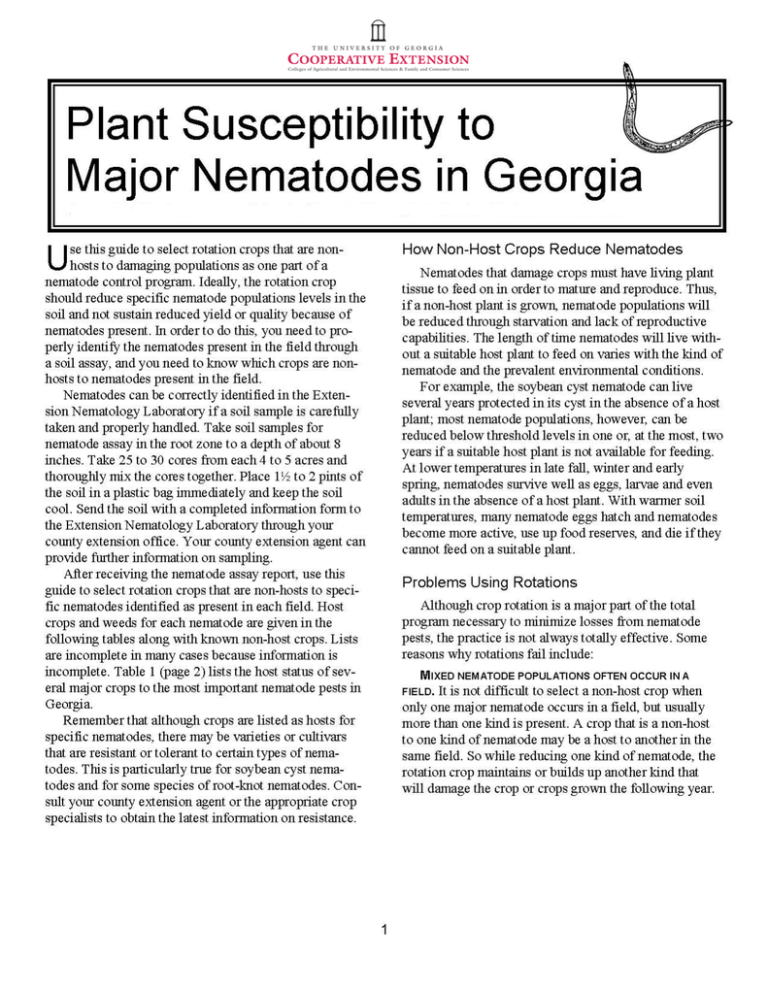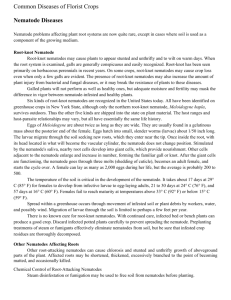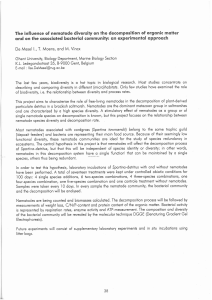Document 12948461
advertisement

How to Use This Guide A SPECIES OF ROOT-KNOT NEMATODE THAT HAS NOT As you study this guide, note that four different species of root-knot nematodes are present in Georgia, each with a different host range. Of these, southern, peanut and Javanese are the most important. The Extension Nematology Laboratory will identify root-knot nematode species upon request – provided fresh, heavily-galled roots are sent in and a complete cropping history is furnished for the field in question. BEEN IDENTIFIED OCCURS. Look first at Table 1 to determine which nematodes affect each major field crop. A non-host crop may be selected from this table. If additional study of host plants or non-host plants is desirable, turn to the page on the specific kind of nematode that has been identified on your farm. Select a nonhost crop that will best fit your farming operation but will not build up nematode populations identified as present in the field to damaging levels. Although information is not available for all nematodes on all plants, remember that each of the more economically important crops grown in Georgia is damaged more by some nematodes than by others. Maintain close communication with your county extension agent or specialist in order to make the appropriate decision on crop rotation for your specific situation. Study weed-hosts of major nematodes as given in Table 2 (page 3). Remember that good weed control can be an important part of a nematode control program. UNCONTROLLED GRASSES AND BROAD-LEAF WEEDS MAY SUPPORT NEMATODE POPULATIONS EVEN THOUGH A NON- Although the crop selected for rotation is not affected by the nematodes, infestation of grass- or weed-hosts may cause the buildup of nematodes capable of attacking subsequent crops. Weed-hosts for each nematode are included in Table 2 (page 3). Good weed control is important with rotation as part of an effective nematode control program. HOST CROP IS BEING GROWN. This guide and the Guide to Interpreting Nematode Assays (available from your county extension office) can be used to develop a total nematode control program for most nematode problems in major field crops grown in Georgia. Table 1. Field Crops that Are Hosts or Non-Hosts to Major Nematodes Southern root-knot Peanut root-knot Javanese root-knot Sting Soybean cyst Reniform Lance Stubby root Lesion (P. brachyurus) Tobacco + + + - - + - + + Corn + + + + - - + + + - Peanuts - + - - - - - + + + Soybeans + + + + + + + + + - Cotton + - - + - + + + + - Small grain + + + + - - + + + + Grain sorghum + + + + - - + + - Alfalfa + + + + -* + + Lespedeza + + + + + Coastal Bermudagrass - - - + - Crop + = host + - = non-host For additional information on crop-hosts or non-hosts, see the pages on particular kinds of nematodes. *One plant introduction line showed susceptibility. All other varieties or lines tested were immune or resistant. 2 + Ring (C. xenoplex) - Table 2. Weeds that Are Hosts or Non-Hosts to Major Nematodes Southern root-knot Peanut root-knot Javanese root-knot Sting Nutgrass + + + + Crabgrass + + + + Sicklepod (C. obtusifolia) + + Horseweed + Morning glory + + Lambsquarter + + + Pigweed + + + Beggarweed - - - Crop Reniform Lance Ring (C. xenoplex) + - + - + + + + + + + - - - + Bermudagrass + + + + + Johnsongrass - + + Bahiagrass + Prickly sida + = host Lesion (P. brachyurus) + Ragweed Mexican teaweed Stubby root + +- Cockebur Texas panicum Soybean cyst + + - + - + + - = non-host For additional information on weed-hosts, see the pages on particular kinds of nematodes. 3 + + - + - Kinds of Nematodes Southern Root-Knot Nematode – Meloidogyne incognita Crop-Host Plants Weed-Host Plants Non-Host or Poor-Host Plants Favorable Soil Types cotton corn soybeans tobacco grain sorghum peaches sunflower wheat oats rye barley alfalfa bahiagrass vegetables: nutsedge (yellow and peanuts strawberry Coastal bermudagrass Coastcross I jimsonweed marigolds (T. patula) johnsongrass horsenettle ragweed beggarweed Sericea lespedeza While damage is usually most severe in sandy to sandy loam soils, root-knot nematodes may also cause severe damage in clay soils. purple) barnyard grass dandelion crabgrass Penn. smartweed spiny pigweed redroot pigweed pokeweed chickweed horseweed spurge Mexican teaweed annual morning glory tall ironweed lambsquarter black nightshade sicklepod (C. obtusifolia) (okra, tomatoes, snap and lima beans, cucumbers, lettuce, carrots, beets, pumpkin, cantaloupe, onions, peppers, cabbage, sweet potatoes, Irish potatoes) (cv. Serala 76 and Interstate 76) Vetch (cv. Cahaba white, Nova II, Vanguard and Vantage) Peanut Root-Knot Nematode – Meloidogyne arenaria Crop-Host Plants Weed-Host Plants Non-Host or Poor-Host Plants Favorable Soil Types peanuts tobacco soybeans sunflower alfalfa bahiagrass peaches grain sorghum wheat oats rye barley vegetables: pigweed lambsquarter sicklepod (C. obtusifolia) prickly sida jimsonweed crabgrass morning glory Texas panicum Florida beggarweed cotton Ccoastal bermudagrass sweet potato strawberry coffee senna (C. occidentalis) hemp sesbania marigolds (T. patula) While damage is usually severe in sandy to sandy loam soils, root-knot nematodes may also cause severe damage in clay soils. (tall, small flower, cypress-vine, bigroot) (peppers, eggplant, Irish potatoes, beets, tomatoes, onions, cucumbers, squash, cowpeas) Host suitability is based on research and field observations. 4 Javanese Root-Knot Nematode – Meloidogyne javanica Crop-Host Plants Weed-Host Plants Non-Host or Poor-Host Plants Favorable Soil Types soybeans tobacco corn oats barley grain sorghum wheat rye bahiagrass alfalfa sunflower lespedeza vetch clovers cowpeas vegetables: pigweed crabgrass lambsquarter nutsedge (yellow and purple) common bermudagrass peanuts cotton pepper strawberry sweet potato Coastal bermudagrass ragweed beggarweed marigold (T. patula) While damage is usually most severe in sandy to sandy loam soils, root-knot nematodes may also cause severe damage in clay soils. (okra, cantaloupe, tomatoes, watermelon, carrots, squash, beans, beets, onions, egg-plant, Irish potatoes, lettuce, cabbage) Northern Root-Knot Nematode – Meloidogyne hapla* Crop-Host Plants Weed-Host Plants Non-Host or Poor-Host Plants Favorable Soil Types peanuts tobacco soybeans strawberry alfalfa sunflower peaches morning glory sorrel curled dock knotweed lambsquarter Florida beggarweed sow thistle pigweed dandelion Coastal bermudagrass corn oats rye wheat barley cotton watermelon okra ragweed Coastcross I While damage is usually most severe in sandy to sandy loam soils, root-knot nematodes may also cause severe damage in clay soils. vegetables: (tomatoes, onions, sweet potatoes, snap & lima beans, squash, pepper, eggplant, lettuce, cucumbers, mustard, cantaloupe, carrots, turnips, Irish potatoes) Sericea lespedeza (cv. Serala 76, Interstate 76) *Least prevalent root-knot nematode species in Georgia. Host suitability is based on research and field observations. 5 Soybean Cyst Nematode – Heterodera glycines Crop-Host Plants Weed-Host Plants Non-Host or Poor-Host Plants Favorable Soil Types soybeans snapbeans Sericea lespedeza Vetch, common Lespedeza (common & Korean) low hop clover hemp sesbania common perslane sicklepod (C. obtusifolia) coffee bean (Casia tora) chickweed (common, mouse-eared) cranesbill henbit deadnettle wild soybeans mullein pokeweed corn cotton peanuts grain sorghum oats tall fescue barley rye wheat tobacco Severe damage may be found in soils ranging from light sandy to heavy clay soils. Lance Nematode – Hoplolaimus columbus* Crop-Host Plants Weed-Host Plants Non-Host or Poor-Host Plants Favorable Soil Types cotton soybean corn turfgrasses: redroot pigweed sicklepod (C. obtusifolia) purple nutsedge tall morning glory crotalaria yellow nutsedge johnsongrass barnyard grass common bermudagrass spiny pigweed goosegrass sweet potato pepper tomato carpetgrass ryegrass bahiagrass tall fescue cocklebur peanuts Found primarily in sandy to sandy loam soils. (bermudagrass, zoysia, millet, St. Augustine, centipede vegetables: (lima & snap beans, watermelon, okra, Southern peas/cowpeas, cucumbers, cantaloupe) small grain (wheat, barley) Host suitability is based on research and field observations. *Host plants of another species, Hoplolaimus galeatus, include cotton, corn, alfalfa, red and white clover, hairy vetch, most major turfgrasses and crabgrass. 6 Sting Nematode – Belonolaimus ssp. Crop-Host Plants Weed-Host Plants Non-Host or Poor-Host Plants Favorable Soil Types cotton soybeans corn milo pearl millet sorghum sunflower Coastal bermudagrass crimson clover white clover Kobe lespedeza strawberry turfgrasses: grasses: peanuts (Georgia only) tobacco watermelon horseweed okra asparagus sandbur pokeweed buckhorn Coastal bermudagrass Distribution is limited to sandy soils of a coarse texture. (crabgrass, johnsongrass, dallisgrass, bahiagrass, nutsedge, bermudagrass) broadleaved: (morning glory, ragweed, cocklebur, Florida beggarweed, curled dock, sorrel, dandelion, jimson weed, lambsquarter) (centipede, zoysia, bermudagrass, ryegrass, fescue, St. Augustine) small grains: (rye, wheat, oats, barley) vegetables: (peppers, squash, cucumbers, lettuce, beans, cowpeas, eggplant, Irish potatoes, carrots, turnips, tomatoes, sweet potatoes, onions, cantaloupe) Host suitability is based on research and field observations. Reniform Nematode – Rotylenchulus reniformis Crop-Host Plants Weed-Host Plants Non-Host or Poor-Host Plants Favorable Soil Types cotton soybeans sunflower clover: crimson, red, white hairy vetch vegetables: black nightshade hairy vetch coffee weed (Cassia tora) Crotalaria spectabilis purslane annual sow thistle beggarweed cocklebur barnyard grass common bermudagrass St. Augustinegrass dallisgrass mustard okra oats peanuts onion pepper, sweet and hot spinach turnip sorghum corn Does not appear to be seriously affected by soil type. Has been found in Georgia on sandy, sandy loams, clay loams and clay soils. (okra, squash, cabbage, beets, carrots, tomatoes, lettuce, lima and snap beans, cowpea, eggplant, Irish potatoes, onions, cantaloupe, watermelon, sweet potatoes, cucumbers, pumpkin) 7 Stubby-Root Nematode – Paratrichodorus christiei Crop-Host Plants Weed-Host Plants Non-Host or Poor-Host Plants Favorable Soil Types corn cotton peaches tomato wheat, oats tall fescue clover: crimson, red, white vetch soybeans alfalfa, ryegrass azalea sudangrass onion lespedeza mustard, turnip cabbage lettuce barley pearl millet peanuts, beans eggplants squash, okra sweet pepper Coastal bermudagrass Research is not available. asparagus jimsonweed Crotalaria spectabilis tobacco rye spinach strawberry cucumber bahiagrass Stubby-root nematodes may be found in a wide range of soil types but cause greatest damage to plants in lightertextured, sandy to sandy loam soils. Host suitability is based on research and field observations. Ring Nematode – Criconemella ornata*, xenoplax* Crop-Host Plants Weed-Host Plants Host plants on which nematodes are maintained or increased: C. ornata C. xenoplax C. xenoplax peanuts corn centipedegrass1 St. Augustinegrass1 soybeans cotton bermudagrass1 1 peaches** grapes1 rotundifolia holly1 helleri holly1 soybeans grain sorghum cowpea Non-Host or Poor-Host Plants C. ornata: peaches curly dock perennial ryegrass vetch hairy vetch cowpea trefoil: (dwarf English, birdsfoot, big, narrowleaf birdsfoot) clover: (ball, crimson, rose, subterranean) striate lespedeza partridge pea C. xenoplax small grains bahiagrass: pensicola, Argentine, P-22 broadleaf signalgrass Carolina geranium peanut cotton bermudagrass orchardgrass purslane alfalfa fescue: tall, hard, annual Ring nematodes have a well-developed spear for feeding on roots. They build up to high numbers around the roots of susceptible host plants. However, with annuals, research has not shown a consistent growth and/or yield response from control of ring nematodes. With certain grasses and woody perennials, ring ssp. may build up to damaging levels over long periods of time. * Other species may be present in the state but are not commonly found. ** Published research indicates that this species of ring is involved in peach tree short life. 1 Injury to roots and reduced growth reported. 8 Lesion Nematode – Pratylenchus brachyurus (Pb) Crop-Host Plants Weed-Host Plants Non-Host or Poor-Host Plants Favorable Soil Types peanuts cotton soybeans corn tobacco alfalfa oats rye wheat barley clover: red, crimson, ladino strawberry millet common vetch watermelon sorghum cucumber pepper cowpea Irish potato tomato coastal bermudagrass crabgrass bermudagrass bahiagrass beggarweed ragweed goosegrass (E. indica) Research is not available. May be found in soils ranging from sandy to heavy clay. Host suitability is based on research and field observations. In Georgia at this time, control recommendations are made for P. brachyurus (Pb) on peanuts. This species may also damage cotton, tobacco and soybeans. P. zeae (Pz) builds up to high numbers on corn, soybeans, small grains, grain sorghum and members of the grass family. P. vulnus (Pv) can cause damage on peaches and woody ornamentals. Other nematode species that occur in Georgia and may cause damage occasionally are listed below. The full effect of these genera has not been clearly demonstrated. Peltamigratus spp. Found in high numbers associated with problem soybean fields or turf. Scutellonema spp. (Spiral nematodes) Found in high numbers associated with problem soybean fields. Helicotylenchus dihystera (Spiral nematodes) Found in high numbers sometimes associated with problem fields of soybeans. However, a clear cause-effect relationship between number of spiral and injury to soybeans has not been established. The species may be found associated with cotton, corn, turf, ornamentals and many other crops. Except for isolated cases, spiral nematodes are not considered of economic importance in Georgia. Tylenchorhynchus spp. These nematodes have been reported as important pathogens on turf, ornamentals, field crops and many other plants, but are only occasionally found in high populations in Georgia. Pathogenicity data for Georgia situations are incomplete. Xiphinema spp. Found in low to high populations around many plants ranging from turf to field crops to fruit trees to ornamentals. Their pathogenic role in plant damage in Georgia has not been established. 9 References: Northern Root-Knot References: Lance Nematodes Davidson, T.R., and J.L. Townherd. 1967. Some Weed Hosts of the Southern Root-Knot Nematode, Meloidogyne incognita. Nematologica, Vol. 13: 452-458. Gaskin, Timothy A., and H.W. Crittenden. 1956. Studies of the Host Range of Meloidogyne hapla. Plant Disease Reporter, Vol. 40: 265-266. McGlohon, Norman, J.N. Sasser, and R.T. Sherwood. 1961. Investigations of Plant Parasitic Nematodes Associated with Forage Crops in North Carolina. N.C. Agriculture Experiment Station Tech. Bulletin 148. Rodriguez-Kebana, Peggy, S. King, Gale Buchanan, and Don Murray. 1978. Susceptibility of Common Weed Species to Meloidogyne arenaria. Proc. Amer. Phytopathological Society. Sasser, J.N. 1954. Identification and Host Parasite Relationships of Certain Root-Knot Nematodes (Meloidogyne spp.) Fassuliotis, G. 1974. Host Range of the Columbia Lance Nematode, Hoplolaimus columbus. Plant Disease Reporter, Vol. 58: 1000-1002. Hogger, C.H., and G.W. Bird. 1976. Nematodes in Georgia Cotton and Soybean Fields. Plant Disease Reporter, Vol. 60: 223-226. Lewis, Stephen A., and Fred H. Smith. 1976. Host Plants, Distribution and Ecological Association of Hoplolaimus columbus. Journal of Nematology, Vol. 8: 264270. References: Reniform Nematodes Birchfield, Wray, and L.R. Brister. 1962. New Hosts and Non-Hosts of Reniform Nematodes. Plant Disease Reporter, Vol. 46: 683-685. Linford, M.B., and Francis Yap. 1940. Some Host Plants of the Reniform Nematode in Hawaii. Proc. Helmin. Society, Washington, DC, Vol. 7: 42-44. Peacock, F.C. 1956. The Reniform Nematode in the Gold Coast. Nematologica, Vol. 1: 307-310. Steiner, G. 1949. Plant Nematodes the Grower Should Know. Proc. Soil Sci. Florida (1942), 4-b: 72-117. References: Soybean Cyst Nematodes Epps, James M., and A.Y. Chambers. 1958. New Host Records for Heterodera glycines; Including One Host in the Laniatae. Plant Disease Reporter, Vol. 42: 194. Riggs, R.D., and M.L. Hambien. 1962. Soybean Cyst Nematode Host Studies in the Family Leguminosae. Arkansas Agriculture Experiment Station Report Series 110. 20 pp. Riggs, R.D., and M.L. Hamblen. 1962. Additional Hosts of Heterodera glycines. Plant Disease Reporter, Vol. 50: 15-16. Smart, Grover C. 1964. Additional Hosts of the Soybean Cyst Nematode, Heterodera glycines, Including Hosts in Two Additional Plant Families. Plant Disease Reporter, Vol. 48: 383-390. References: Lesion Nematodes Brodie, Bill B., J.M. Good, and C.A. Jaworski. 1970. Population Dynamics of Plant Parasitic Nematodes in Cultivated Soil: Effect of Summer Cover Crops in Old Agricultural Land. Journal of Nematology, Vol. 2: 147151. Endo, B.Y. 1959. Responses of Root Lesion Nematodes Pratylenchus brachyurus and P. zeae to Various Plants and Soil Types. Phytopathology, Vol. 49: 417-421. References: Stubby-Root Nematodes References: Sting Nematodes Coursen, B.W., R.A. Rhode, and W.R. Jenkins. 1958. Addition to the Host Lists of the Nematodes Pratylenchus projectus and Trichodorus christiei. Plant Disease Reporter, Vol. 42: 456-460. Rhode, R.A., and W.R. Jenkins. 1957. Host Range of a Species of Trichodorus and its Host Parasite Relationships on Tomato. Phytopathology, Vol. 471: 295-298. Hoff, John K., and W.F. Mai. 1962. Pathogenicity of the Stubby-Root Nematode to Onion. Plant Disease Reporter, Vol. 46: 24-25. Christie, J.R. 1959. Plant Nematodes: Their Bionomics and Control. University of Florida Agricultural Experiment Station, Gainesville, pp. 129-132. Holdeman, Q.L., and T.W. Graham. 1953. The Effect of Different Species on the Population Trends of the Sting Nematodes. Plant Disease Reporter, Vol. 37: 497-500. Good, J.M. 1972. Proceedings: Tall Timbers Conference on Ecological Animal Control by Habitat Management. No. 4, Tall Timbers Research Station, Tallahassee, FL. 10 References: Ring Nematodes chemistry of Criconemoides xenoplax and C. ornata on Peach. Journal of Nematology, Vol 20: 40-46. Nyczepir, A.P., and P.F. Bertrand. 1990. Host Suitability of Selected Small Grain and Field Crops to Criconemoides xenoplax. Plant Disease Reporter. Weaver, D.J., E.J. Wehunt, and W.M. Dowler. 1974. Association of Tree Site, Pseudomonas syringae, Criconemoides xenoplax and Primary Date with Short Life of peach Trees in Georgia. Plant Disease Reporter, Vol. 58: 76-79. Zehr, E.I., J.B. Aitken, J.M. Scott, and J.R. Meyer. 1990. Additional Hosts for the Ring Nematode, Criconemoides xenoplax. Journal of Nematology, Vol. 22: 86-89. Zehr, E.I., S.A. Lewis, and M.J. Bonner. 1986. Some Herbaceous Hosts of the Ring Nematode, Criconemoides xenoplax. Plant Disease, Vol. 70: 1066-1069. Aycock, R., K.R. Barker, and D.M. Benson. 1976. Susceptibility of Japanese Holly to Criconemoides xenoplax, Tylenchorhynchus claytoni and Certain Other Plant Parasitic Nematodes. Journal of Nematology, Vol. 8: 26-31. Hassan, Mojtahedi, and B.F. Lownsbery. 1975. Pathogenicity of Criconemoides xenoplax Experimentally Associated with a Disease of Peach. Phytopathology, Vol. 63: 994-997. Lownsbery, B.F., Harvey English, E.H. Moody, and F.J. Shick. Criconemoides xenoplax Experimentally Associated with a Disease of Peach. Phytopathology, Vol. 63: 994-997. Minton, Norman A., and D.K. Bell. 1969. Criconemoides ornatus Parasitic on Peanuts. Journal of Nematology, Vol. 1: 349-351. Nyczepir, A.P., C.C. Reilly, R.E. Motsinger, and W.R. Okie. 1988. Behavior, Parsitism, Morphology and Bio- 11 Bulletin 904 Reviewed May 2009 The University of Georgia and Ft. Valley State University, the U.S. Department of Agriculture and counties of the state cooperating. Cooperative Extension, the University of Georgia College of Agricultural and Environmental Sciences, offers educational programs, assistance and materials to all people without regard to race, color, national origin, age, gender or disability. An Equal Opportunity Employer/Affirmative Action Organization Committed to a Diverse Work Force







